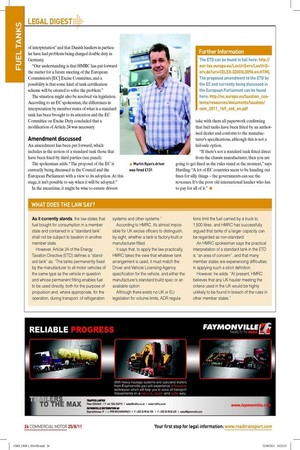WHAT DOES THE LAW SAY?
Page 22

If you've noticed an error in this article please click here to report it so we can fix it.
As it currently stands, the law states that fuel bought for consumption in a member state and contained in a “standard tank” shall not be subject to taxation in another member state.
However, Article 24 of the Energy Taxation Directive (ETD) defines a “standard tank” as: “The tanks permanently fixed by the manufacturer to all motor vehicles of the same type as the vehicle in question and whose permanent fitting enables fuel to be used directly, both for the purpose of propulsion and, where appropriate, for the operation, during transport, of refrigeration systems and other systems.” According to HMRC, it’s almost impossible for UK excise officers to distinguish, by sight, whether a tank is factory-built or manufacturer-fitted.
It says that, to apply the law practically, HMRC takes the view that whatever tank arrangement is used, it must match the Driver and Vehicle Licensing Agency specification for the vehicle, and either the manufacturer’s standard build spec or an available option.
Although there exists no UK or EU legislation for volume limits, ADR regula tions limit the fuel carried by a truck to 1,500 litres, and HMRC has successfully argued that tanks of a larger capacity can be regarded as non-standard.
An HMRC spokesman says the practical interpretation of a standard tank in the ETD is “an area of concern”, and that many member states are experiencing difficulties in applying such a strict definition.
However, he adds: “At present, HMRC believes that any UK haulier meeting the criteria used in the UK would be highly unlikely to be found in breach of the rules in other member states.”














































